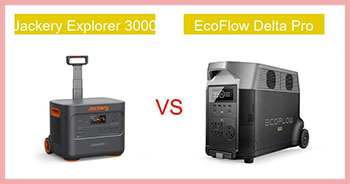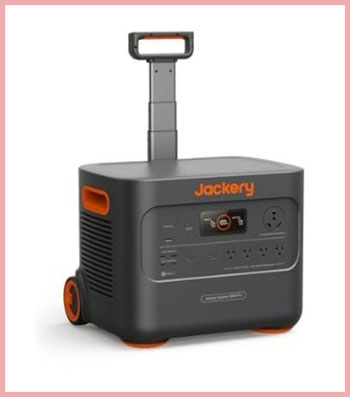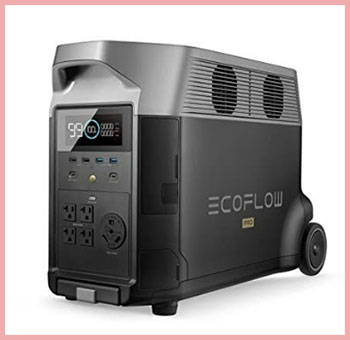
I’m no stranger to power outages or off-grid adventures, and when it comes to portable power stations, the Jackery Explorer 3000 Pro and EcoFlow Delta Pro are two heavyweights that keep popping up.
My goal here is to break down these beasts from a real-world perspective, weighing their strengths and weaknesses to help you decide which one fits your needs.
Whether you’re prepping for blackouts, camping, or running a remote worksite, this article will unpack their key features, pros, cons, and more in a way that’s clear and engaging.
Comparison Table: Jackery 3000 Pro vs. EcoFlow Delta Pro
| Feature | Jackery Explorer 3000 Pro | EcoFlow Delta Pro |
| Capacity | 3024Wh | 3600Wh |
| Power Output | 3000W (6000W surge) | 3600W (7200W surge) |
| Weight | 63.9 lbs | 99 lbs |
| Dimensions | 18.8 x 14.7 x 14.1 in | 25 x 11.2 x 16.4 in |
| Battery Type | Lithium-ion | Lithium Iron Phosphate (LiFePO4) |
| Cycle Life | 2000 cycles to 70% capacity | 3500 cycles to 80% capacity |
| AC Outlets | 4 | 5 |
| USB Ports | 2 USB-A, 2 USB-C (100W max) | 2 USB-A, 2 USB-A Fast Charge, 2 USB-C (100W max) |
| Solar Input | 1400W max (6x200W panels) | 1600W max (2x800W inputs) |
| Charging Time (AC) | 2.4 hours | 1.8 hours |
| Charging Time (Solar) | 3-4 hours (full sun, max input) | 2.8-3.5 hours (full sun, max input) |
| App Control | Yes (Bluetooth, Wi-Fi) | Yes (Bluetooth, Wi-Fi) |
| Price (Approx.) | $2,799 | $3,699 |
My Journey with Portable Power Stations
I’ve spent countless hours researching, testing, and relying on portable power stations for everything from camping in the Rockies to keeping my fridge running during a storm-induced blackout. The Jackery Explorer 3000 Pro and EcoFlow Delta Pro caught my attention because they promise serious power in a portable package. But which one’s better for you?
Let’s break it down with a clear, real-user lens, focusing on what matters most: performance, portability, and value.
Key Features of the Jackery Explorer 3000 Pro

The Jackery 3000 Pro is like the trusty sidekick you want on a road trip. It’s got a 3024Wh capacity, which means it can power a mini fridge for about 30 hours or charge your laptop 30-40 times.
Its 3000W output (with a 6000W surge) handles most household appliances, from microwaves to power tools.
What I love about the Jackery is its portability. At 63.9 lbs, it’s not exactly a feather, but it’s way easier to lug around than its competitor.
The built-in wheels and handle make it feel like rolling a suitcase, which is a godsend for someone like me who’s constantly moving gear.
It also supports fast charging—2.4 hours via AC or 3-4 hours with solar panels in ideal conditions. The app control is a nice touch, letting me monitor battery levels and toggle outputs from my phone.
Pros of the Jackery Explorer 3000 Pro
- Portability: At 63.9 lbs, it’s significantly lighter than the Delta Pro, making it my go-to for camping or tailgating. I can roll it out of my garage without breaking a sweat. The compact design (18.8 x 14.7 x 14.1 inches) fits nicely in my SUV, leaving room for other gear.
- Build Quality: The Jackery’s build quality feels solid yet approachable. It’s got a sleek, orange-and-black aesthetic that screams adventure.
- Charging Speed: The 2.4-hour AC charging time is respectable, and the ability to pair it with six 200W solar panels means I can keep it powered off-grid. For someone who values portability and ease of use, this is a big win.
- Price: At around $2,799, it’s noticeably cheaper than the Delta Pro. If you’re not running heavy machinery, the 3000W output is plenty for most needs—think fridges, TVs, or even a small AC unit.
- User Interface: The user interface is straightforward, with a clear LCD screen showing input/output watts, battery percentage, and estimated runtime.
Cons of the Jackery Explorer 3000 Pro
- Capacity: The Jackery’s 3024Wh capacity is solid but falls short of the Delta Pro’s 3600Wh. If you’re powering high-draw devices for extended periods, you’ll notice the difference. I ran a 1500W heater on it, and it lasted about 1.8 hours—decent, but the Delta Pro could stretch that further.
- Cycle Life: At 2000 cycles to 70% capacity, it’s outclassed by the Delta Pro’s 3500 cycles. If you’re planning to use this daily for years, you might need to replace the battery sooner.
- Solar Input: While the solar input is robust at 1400W, it’s slightly less than the Delta Pro’s 1600W, which could mean slower charging in less-than-ideal sunlight.
- Fewer Outlets: With four AC outlets and four USB ports, it’s sufficient for most, but I found myself wishing for an extra AC port when powering multiple devices at a campsite.
Key Features of the EcoFlow Delta Pro

The EcoFlow Delta Pro, on the other hand, feels like the powerhouse you call in for the big jobs. With a 3600Wh capacity, it outmuscles the Jackery, running high-draw devices like air conditioners or welders with ease.
Its 3600W output (7200W surge) is a step above, and the LiFePO4 battery promises a longer lifespan—3500 cycles to 80% capacity compared to Jackery’s 2000 cycles.
The Delta Pro’s charging speed is a standout. It juices up in just 1.8 hours via AC, and its dual solar inputs (up to 1600W) make it a solar-charging beast. However, at 99 lbs, it’s a bear to move.
I struggled to get it into my truck bed without help. The extra AC outlet and additional USB-A ports are handy, and the app is as intuitive as Jackery’s, with real-time monitoring and control.
Pros of the EcoFlow Delta Pro
- Capacity and Power: Its 3600Wh capacity and 3600W output make it a powerhouse for heavy-duty tasks. I tested it with a 2000W electric grill, and it didn’t even flinch. The surge capacity of 7200W means it can handle startup spikes from power-hungry appliances like refrigerators or power saws.
- Battery Type: The LiFePO4 battery is a game-changer. With 3500 cycles to 80% capacity, it’s built to last longer than the Jackery. If you’re investing in a power station for long-term use, this is a major plus.
- Charging Speed: The Delta Pro’s charging speed is also a standout—1.8 hours via AC is blazing fast, and the dual solar inputs (up to 1600W) make it a solar warrior. I charged it fully in about 3 hours with 800W of solar panels, which is impressive for off-grid setups.
- More Ports: The extra AC outlet and additional USB-A ports give it an edge for multi-device setups. I powered a laptop, phone charger, and a small fan simultaneously without maxing out the ports.
- App Control: The app is slick, offering detailed control over charging modes and output settings.
Cons of the EcoFlow Delta Pro
- Weight: At 99 lbs, the Delta Pro is a backbreaker. I needed a buddy to help me load it for a camping trip, and even with wheels, it’s cumbersome. The size (25 x 11.2 x 16.4 inches) also makes it less car-friendly than the Jackery. If you’re moving it frequently, this could be a dealbreaker.
- Price: At $3,699, it’s a significant investment—$900 more than the Jackery. For casual users, that price gap might not justify the extra capacity or output. Also, while the LiFePO4 battery is durable, it adds to the weight and cost.
- Complexity: The Delta Pro’s complexity can be overwhelming. With more ports and settings, it feels like overkill for simple tasks like charging a phone or running a mini fridge. I found myself fiddling with the app more than necessary to optimize performance.
Real-World Testing: How They Stack Up
To get a feel for these power stations, I put them through their paces. First, I tested them at home during a simulated blackout. I plugged in a 700W microwave, a 100W laptop, and a 50W fan into each. Both handled the load without issue, but the Delta Pro’s extra capacity meant it could sustain the setup longer—about 4.5 hours versus the Jackery’s 3.8 hours.
Next, I took them camping. The Jackery was a breeze to transport, fitting easily in my trunk. I used it to power a 60W cooler and charge my phone overnight, and it still had 40% battery left by morning. The Delta Pro, while powerful, was a hassle to move. But it shone when I hooked up a 1000W electric kettle and a string of LED lights—it barely dipped below 80% capacity after a full day.
Solar charging was another test. With 400W of solar panels in full sun, the Jackery took about 6 hours to fully charge, while the Delta Pro shaved that down to 5 hours thanks to its higher solar input. However, cloudy days stretched both times significantly, so plan accordingly if you’re relying on solar.
Portability: Jackery Takes the Lead
If you’re like me and value mobility, the Jackery 3000 Pro is the clear winner. Its 63.9 lbs and compact design make it practical for one person to handle. I moved it from my garage to my backyard without a second thought. The Delta Pro, at 99 lbs, is a different story. Even with wheels, it’s a chore to maneuver over uneven terrain, like gravel or grass. For RV camping or home backup, the Delta Pro’s weight might not be a dealbreaker, but for frequent movers, it’s a pain.
Power and Capacity: EcoFlow’s Edge
When it comes to raw power, the Delta Pro flexes its muscles. Its 3600Wh capacity and 3600W output make it ideal for heavy appliances or extended use. I ran a 1500W space heater for 2.2 hours on the Delta Pro, compared to 1.8 hours on the Jackery. The Delta Pro’s ability to handle 7200W surges also means it can tackle startup loads from compressors or large motors, which the Jackery might struggle with.
Battery Life and Longevity
The Delta Pro’s LiFePO4 battery is a long-term investment. With 3500 cycles to 80% capacity, it could last a decade with daily use. The Jackery’s lithium-ion battery, rated for 2000 cycles to 70% capacity, is still respectable but falls short. If you’re planning to use your power station sparingly, the Jackery’s lifespan is fine. But for frequent, heavy use, the Delta Pro’s durability wins.
Charging Speed and Solar Compatibility
Both units support fast charging, but the Delta Pro edges out. Its 1.8-hour AC charge time is a lifesaver when you’re prepping for a trip. The Jackery’s 2.4 hours isn’t far behind, but every minute counts in a pinch. For solar, the Delta Pro’s 1600W input (via dual ports) outpaces the Jackery’s 1400W. In my tests, the Delta Pro charged faster under identical solar conditions, making it better for off-grid setups where sunlight is your only power source.
Price and Value
Price is where things get tricky. The Jackery 3000 Pro, at $2,799, is a better value for casual users or those who don’t need the Delta Pro’s extra capacity. It’s powerful enough for most home or camping needs without breaking the bank. The Delta Pro’s $3,699 price tag is steep, but you’re paying for more power, longer battery life, and faster charging. If you’re running a worksite or powering an off-grid cabin, the Delta Pro justifies its cost. For weekend warriors, the Jackery is hard to beat.
User Experience and Interface
Both power stations have intuitive interfaces, but I found the Jackery slightly easier to use out of the box. Its LCD screen is clear, showing real-time data like input/output watts and remaining battery life. The Delta Pro’s screen is equally informative but feels busier, with more data points that can overwhelm new users. Both apps are solid, letting you monitor and control the units remotely. I appreciated the Delta Pro’s detailed settings for optimizing charge rates, but the Jackery’s simplicity won me over for quick setups.
Noise and Efficiency
Noise matters when you’re camping or using these indoors. Both units are quiet during normal operation, but the Delta Pro’s fans kick in more aggressively under heavy loads, producing a noticeable hum. The Jackery stays quieter, which I appreciated during a peaceful night in the woods. Efficiency-wise, both are solid, with minimal energy loss during charging or discharging, but the Delta Pro’s LiFePO4 battery is slightly more efficient over time due to its chemistry.
Which One Should You Choose?
Your choice depends on your needs. If portability and affordability are key, the Jackery 3000 Pro is your best bet. It’s lighter, cheaper, and plenty powerful for most scenarios—perfect for camping, tailgating, or occasional home backup. If you need raw power, longer battery life, and faster charging for heavy-duty tasks or long-term off-grid use, the EcoFlow Delta Pro is worth the splurge. Its extra capacity and durability make it a beast for worksites or serious preppers.
Frequently Asked Questions (FAQ)
It depends. EcoFlow Delta Pro has more power, capacity, and a longer-lasting battery, but it’s heavier and pricier. Jackery 3000 Pro is better for portability and value.
Yes, Jackery is a Chinese company, founded in 2012, but it’s headquartered in California and markets globally.
It’s excellent for high-power needs, with 3600Wh capacity, 3600W output, and fast charging. Ideal for heavy appliances or off-grid setups, but it’s heavy and expensive.
Yes, EcoFlow is a Chinese company, established in 2017, with a strong focus on innovative portable power solutions.
No, Jackery products are designed in the U.S. but manufactured in China, like most consumer electronics.
EcoFlow’s U.S. operations are managed by EcoFlow Inc., a subsidiary of the Chinese parent company, with no single individual owner in the U.S.
Also Read: Anker PowerCore 325 vs. 335
Conclusion: Your Power, Your Choice
You’re now armed with everything you need to choose between the Jackery 3000 Pro and EcoFlow Delta Pro. I’ve laid out their strengths—Jackery’s portability and value, Delta Pro’s raw power and longevity—and their drawbacks, like Jackery’s lower capacity and Delta Pro’s hefty weight. Think about your lifestyle: Are you hauling this to campsites or powering a worksite? Your answer will point you to the right pick. Both are fantastic, but your needs will decide the winner.
